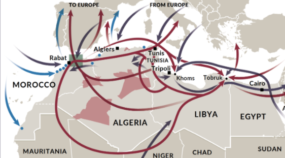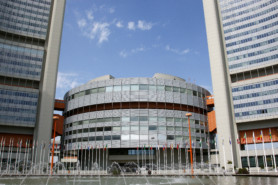Posted on 15 Mar 2018
From a personal perspective, both as a veteran law-enforcement officer and someone raised in an inner-city area that experienced its fair share of drug problems, I have seen first-hand the destructive nature of drug trafficking and drug abuse. I saw my community – and members of my own family – struggling to break the cycles of dependency, poverty and crime.
The current view from the US is a turbulent one. We are in the midst of an opioid epidemic; violent crime is rising again; and the debate around legalization of all illicit drugs is in full swing. It is a global debate and one that was prominent at the UN General Assembly Special Session on Drugs (UNGASS) in 2016.
I would like here to draw on my own experience of working in the field of drug law enforcement throughout the horribly misnamed ‘war on drugs’ in the US, and to make the case that the lessons learnt in those troubled times should not now be forgotten.
In New York during the 1980s, the US Drug Enforcement Administration (DEA) primarily concentrated on fighting transnational organized crime and the heroin trade. Once crack cocaine hit the streets, inner-city neighbourhoods became war zones, violent crime skyrocketed and the murder rate climbed to over 2 000 murders a year, reaching its peak in 1990 (2 605 murders). Residents lived in fear of shootings.
The city government asked the DEA for assistance – and that of other government agencies – and hence the National Drug Control Strategy was formed. This included drug education, treatment for users and supply reduction – the latter targeting law-enforcement efforts at drug cartels. Although the 1980s and 1990s were difficult times to work in drug law enforcement, significant successes were recorded. Heroin use became almost non-existent; cocaine use dropped by 32%; marijuana use among teenagers diminished by 25%; and violent crime fell by 50%. We saw a correlation between violent crime and drug use. Another collateral benefit of employing a drug-prevention strategy was that it had a positive impact on the overall US crime rate.
The US experience in the marijuana legalization debate
The US Congress agrees on very little, yet on the issue of marijuana legalization there is bipartisan agreement. So far, nine US states and the federal District of Columbia have legalized marijuana. I would venture to say that none of these have taken the opportunity to read the science and obtain the facts. The pro-legalization lobby continues to promote the benefits and safety of marijuana use. However, as analysis from the Institute for a Drug-Free Workplace illustrates, many of the pro-legalization arguments are myths. For example, the argument that marijuana legalization will reduce prison populations goes against Department of Justice statistics, which indicate that less than 0.7% of inmates are imprisoned for offences related to marijuana possession.
Similarly, the idea that marijuana is a ‘safe’ drug runs contrary to a host of medical evidence. The National Academies of Sciences, Engineering, and Medicine highlight public-health issues associated with the growing accepted recreational and medical use of the drug. The National Institute on Drug Abuse reported that marijuana is the ‘most commonly used illicit substance in the US. Marijuana impairs short term learning, the ability to focus, and coordination. It increases heart rate, can harm the lungs, and increase the risk of psychosis in vulnerable people. Research further suggests that when regular [marijuana] use begins in the teen years addiction is more likely.’ There is also ongoing research into the complex role that marijuana seems to play in triggering schizophrenia.
Pro-legalization advocates also widely argue that decriminalization and taking a ‘harm reduction’ approach would reduce the impact of organized crime. However, firstly, the harm-reduction concept is, in my view, overly individualistic and does not effectively take into account the wider impacts of drug abuse on communities and families. Secondly, previous experiments with legalization have shown that it may in fact strengthen organized-criminal groups. For example, marijuana has always been a cash crop for Mexican cartels, and legalization has not stemmed the flow of illicitly produced marijuana entering the US from Mexico.
To take another example, Colorado documents the impact of marijuana legalization in that state, and so it serves as an experimental lab for the nation at large. The most recent report from the Rocky Mountain High Intensity Drug Trafficking Area collected data from before and after the introduction of medical and recreational marijuana and found a range of negative impacts, including a 66% increase in marijuana-related traffic deaths compared to the period of pre-legalization for recreational use. Adult past-month use increased by 71% in the three-year average (2013–2015), and Denver’s crime rate increased by 11% from 2013 to 2016.
Contrary to popular claims from the pro-legalization lobby, marijuana legalization initiatives have expanded the robust black market, and marijuana grown in states that have legalized marijuana is finding its way to markets across the US and internationally.
UNGASS 2016 and the need to remember past lessons
In 2016 the US lost 64 000 of its citizens to drug overdoses. In 2015 the US societal cost of heroin use disorder was estimated to be $51.2 billion for 1 008 000 heroin users, and drug overdoses and poisoning are now the leading causes of death among Americans under 50, according to the National Institute on Drug Abuse. In today’s revisionist history, it’s easy to forget what our country went through in the 1980s and it is fashionable to discuss our drug prevention programmes as a failure. Yet much of the available data portrays a very different narrative.
Those who argue for legalization need to be asked: what is their ultimate goal? Experience has shown that legalization does not reduce societal harm. But, by the same token, those who overemphasize the importance of law enforcement should be asked the same question. incarcerating every user is also not an effective strategy. The overall goal is to reduce crime and its effects on our society. Law enforcement understands and supports the need for a comprehensive, multidisciplinary strategy of prevention, treatment and enforcement, which, in combination, would be a successful way of meeting that goal.
The report prepared by the UN General Assembly from the UNGASS 2016 defines what needs to be done. Understanding that the UN has no authority over sovereign states, it underscores the need for a global drug policy and a strategy that is comprehensive, multidisciplinary, fact-driven and science-based. This includes prevention through education, treatment, and greater access to drug-abuse and mental-health data and treatment programmes. But it also includes enforcement, which holds producers and suppliers accountable. Supply creates demand, as the Colorado example has shown.
A comprehensive, unified global approach to the drug problem is needed if the effort is to be successful, one that is grounded in objective scientific knowledge, rather than ideology. The UN has a global mandate, a global platform and the resources to lead this effort. It is here where the most promising future for leading drug policy lies.
As the 61st session of the Commission on Narcotic Drugs gets under way in Vienna, legalization continues to be a central and divisive issue within drug policy debates. To reflect the breadth of debate, the Global Initiative has sought input from leading experts who hold different views on the benefits of legalization.
Opinion pieces are the authors’ own views and do not necessarily reflect those of the GI.



